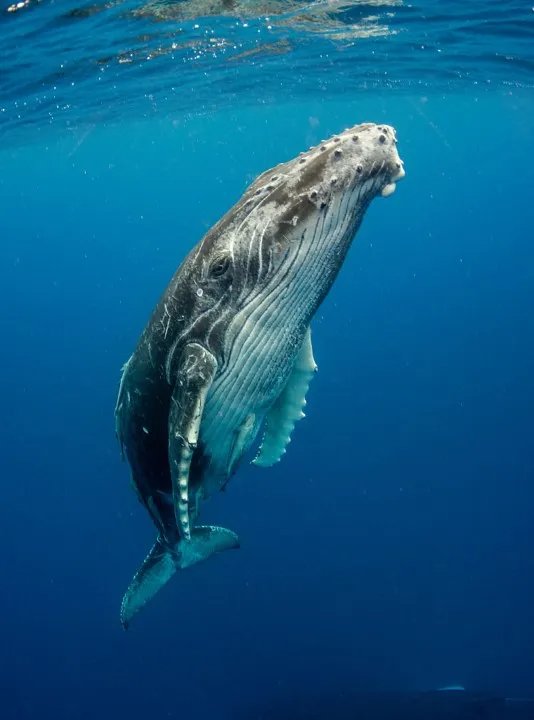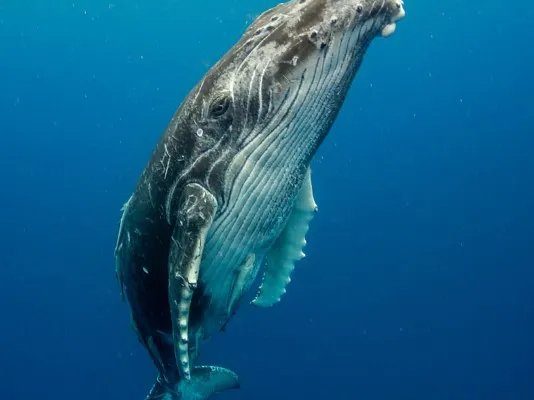
Understanding humpback whales is like unraveling a mystery; there’s always more to learn. Whether you’re an ocean enthusiast or just curious about these incredible mammals, there’s a lot to discover. So, grab your coffee, and let’s dive into some mind-blowing facts about the humpback whale.
1. They Are Mammals, Not Fish
You might be surprised to learn that despite their massive size and aquatic habitat, humpback whales are mammals. Just like us, they breathe air, give birth to live young, and nurse their calves. Their lungs are designed for powerful breathing, allowing them to take in large amounts of air before diving deep into the ocean.
Here’s the thing: when you think of a whale, it’s easy to picture something fishy, but remember that mammals like humpbacks are warm-blooded. They even have hair, although it’s mostly sparse. These features make them more similar to land animals than to fish, highlighting the unique evolutionary path they’ve taken.
2. Their Songs Are Legendary
You might be wondering how humpback whales communicate, especially over long distances. Well, they do so through hauntingly beautiful songs. These songs can last up to 20 minutes and are made up of a series of “notes” that the whales repeat in a particular sequence. What’s even more fascinating is that these songs can travel over 20 miles underwater!
Each male humpback whale has its unique song, which can change from season to season. Scientists believe that these songs are used to attract mates—and maybe even to establish social hierarchies among males. Imagine being underwater and hearing a chorus of whale songs; it’s like nature’s own concert!
3. They Can Grow Really Big
Size-wise, humpback whales are nothing short of impressive. Adult humpbacks typically range from 40 to 60 feet in length and can weigh anywhere from 25 to 40 tons. To put that into perspective, that’s about the size of a school bus!
Despite their enormous size, they are graceful swimmers. They can reach speeds of up to 16 miles per hour when they’re feeling particularly spry. These giants have long pectoral fins that can be up to 15 feet long, which helps them maneuver through the water with elegance and agility. It’s hard not to be in awe of their sheer size and grace!
4. They Are Amazing Divers
Humpback whales are not just about surface show; they are also amazing divers. They can dive for up to 30 minutes at a time, reaching depths of nearly 600 feet while searching for food. Their primary diet consists of small fish and krill, which they catch using a unique feeding technique called bubble net feeding.
During bubble net feeding, a group of whales works together to create a “bubble net” with air that traps fish in a concentrated area. Then, they lunge through the bubbles, capturing their meal with their baleen plates. It’s a showcase of teamwork and intelligence that’s impressive in the animal kingdom.
5. Their Migration is Epic
If you’re looking for a long-distance traveler, look no further than the humpback whale. Every year, these whales undertake one of the longest migrations of any mammal, traveling up to 16,000 miles round-trip. They typically migrate between feeding grounds in cold waters and breeding grounds in warmer tropical waters.
In the summer, humpbacks are found in nutrient-rich waters, where they feast on krill and small fish. As the seasons change and the waters cool, they migrate to warmer breeding areas, often near the coasts of Hawaii or the Caribbean. This epic journey highlights not just their endurance but also their reliance on the health of ocean ecosystems.
6. They Have a Unique Feeding Strategy
Speaking of feeding, the way humpback whales gather their food is quite unique. Besides bubble net feeding, they also use a technique called “lunge feeding.” This method involves swimming rapidly towards a school of fish with their mouths wide open to engulf vast amounts of water and prey.
In addition to bubble nets and lunge feeding, humpbacks can also be seen slapping the water with their fins or tails, which may help to stun fish and make them easier to catch. It’s fascinating to see how these intelligent creatures have developed a variety of strategies to adapt to their environment.
7. They Are Social Animals
Contrary to what you might expect from such large creatures, humpback whales are quite social. They often travel in groups, called pods, which can include a few individuals to over a dozen. Within these pods, you can find complex social interactions that involve play, communication, and even cooperative feeding.
Humpbacks are known to engage in behavior that suggests they enjoy each other’s company. For example, you might see them breaching together or displaying acrobatic moves. This social aspect is vital for their survival and helps strengthen bonds among individuals during migration or feeding.
8. They Play a Crucial Role in the Ecosystem
Humpback whales aren’t just interesting; they are also essential to marine ecosystems. As they swim through the ocean, they contribute to the health of marine life, especially with their waste. Their fecal matter is rich in nutrients and helps fertilize the waters, promoting the growth of phytoplankton.
Phytoplankton are the foundation of the oceanic food web and play a crucial role in absorbing carbon dioxide from the atmosphere. This means that humpback whales help keep the ocean healthy, which is beneficial for our climate as well. Truly, these massive mammals have a significant impact on both the ocean environment and our planet’s health!
9. They Face Several Threats
Sadly, humpback whales face a variety of threats in today’s world. Despite their recovery from near extinction due to whaling, they are still susceptible to dangers like climate change, entanglement in fishing gear, and ship strikes. Moreover, ocean noise pollution can disrupt their communication and navigation.
Conservation efforts are vital to ensuring the continued survival of humpback whales. Organizations around the globe are working to protect their habitats and implement stricter regulations on shipping and fishing practices to minimize harm. Every little effort helps in ensuring these magnificent creatures continue to thrive.
10. They Have Unique Personalities
Just like humans, humpback whales have unique personalities! Some are more playful, while others may be more solitary. Researchers have noted that whales can develop preferences for certain behaviors and even show signs of emotion, such as curiosity or playfulness when interacting with boats or other marine life.
These unique traits make them intriguing to study and observe. When you see a humpback whale breach or tail slap, it’s like catching a glimpse of their individual character and spirit. They are not just animals; they are complex beings with their own behaviors and quirks.
As we reach the end of our exploration into the world of humpback whales, it’s clear that these fascinating creatures are worthy of our admiration and protection. From their epic migrations to their unique feeding strategies, they remind us of the beauty and complexity of life beneath the waves. Understanding these giants helps us appreciate the delicate balance of our ocean ecosystems and the importance of doing our part to protect them for future generations. So, the next time you catch sight of a humpback whale, take a moment to acknowledge not just their size but the incredible story they have to tell.

